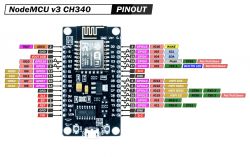Hello
As in the subject, I have a module esp8266 to control a garage door with a reed switch sensor,
everything works as expected until the power goes out :/ and the board does not want to start if it has a high state on the D8 pin (reed switch connected)
Please suggest how to do it differently or how you connect it,
As in the subject, I have a module esp8266 to control a garage door with a reed switch sensor,
everything works as expected until the power goes out :/ and the board does not want to start if it has a high state on the D8 pin (reed switch connected)
Please suggest how to do it differently or how you connect it,







